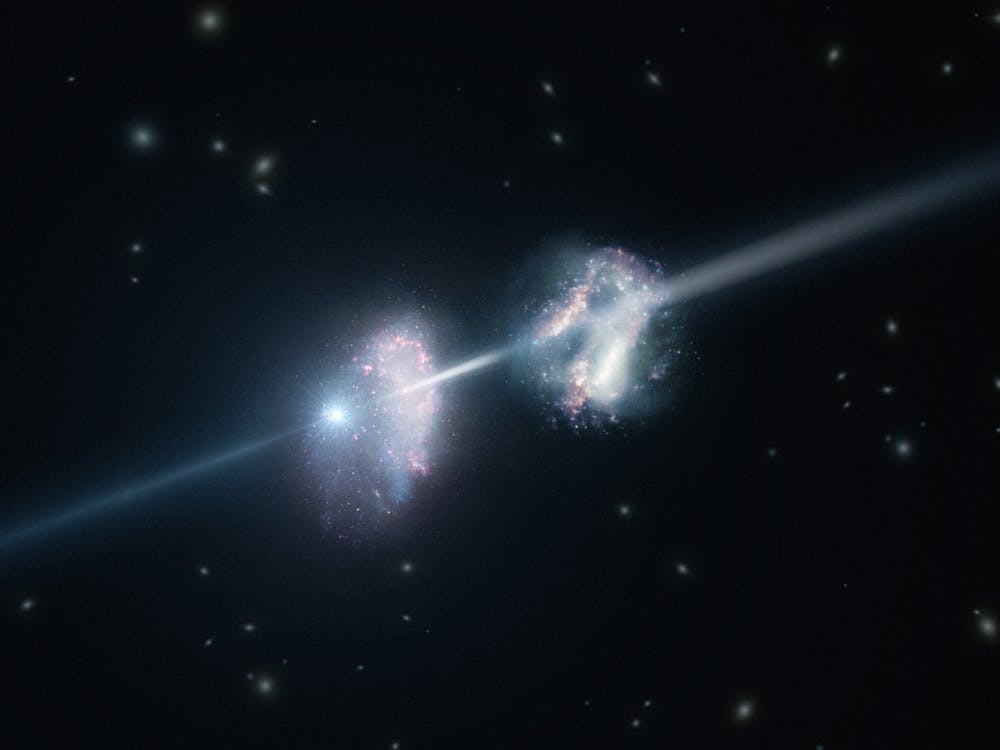As the semester begins to slow down, scientific discovery has not. This week’s science news in review explores new findings from the James Webb Space Telescope, the discovery of a nitrogen-fixing organelle, an accident in molecular evolution and the legacy of Peter Higgs.
Gamma-ray burst mystery: Supernova challenges expectations
In October 2022, the most powerful energetic gamma-ray burst ever recorded struck Earth. The flash, referred to as the “brightest of all time” (BOAT), radiated gamma rays ten times more powerful than anything we have seen before.
Existing knowledge predicted that the origin of the BOAT was a supernova called a collapsar. It is believed that collapsars can create the extreme conditions needed to produce heavy metals through nuclear fusion. However, a recent study observed nothing. No heavy elements were observed in the aftermath of BOAT.
Other studies have confirmed these findings with astronomers failing to produce evidence of heavy element synthesis from collapsars. The absence of these heavy metals raises new questions and challenges in our understanding of supernovae.
Breakthrough: Nitroplast discovered
Scientists have identified a eukaryote (single-celled marine alga) capable of fixing nitrogen from the atmosphere, a process previously thought to be exclusive to prokaryotes. Through endosymbiotic evolution, marine algae have been able to develop a novel organelle called the nitroplast. This is the first known eukaryotic organelle involved with the process of nitrogen fixation.
Chloroplast and mitochondria in eukaryotes were also found to originate from endosymbiosis, which is a mutual relationship between a host and an engulfed organism. After millions of years of evolution, mitochondria and chloroplasts are indispensable for energy production and metabolism in their host eukaryotic cells.
The researchers focused on the bacterium Candidatus Atelocyanobacterium thalassa (UCYN-A) which started living in marina algae 100 million years ago as an endosymbiont. UCYN-A has been integrated into the algae’s cell architecture and functions to import algal proteins and participate in algal cell division.
These clues suggest that UCYN-A and marine algae have been evolving together for a while. The researchers argue that the relationship between marine alga and UCYN-A has progressed beyond simple endosymbiosis, and UCYN-A is functioning as a new nitrogen-fixing organelle, the nitroplast. By harnessing atmospheric nitrogen, alga with nitroplasts could gain a competitive advantage in nutrient-poor oceanic environments. Nitrogen-fixing capabilities in marine alga represent a significant evolutionary event in the symbiotic relationship between eukaryotes and prokaryotes.
Nature's fractal: Protein forms molecular Sierpiński triangle
A group of scientists in Germany have discovered an interesting pattern at the molecular level in the bacterium Synechococcus elongatus. When placed in water, the bacteria’s citrate synthase enzyme assembles itself into an intricate fractal structure known as a Sierpiński triangle. The shape is a triangle consisting of increasingly smaller and smaller triangles.
Fractals are intricate geometric shapes characterized by a continuous pattern. These patterns can be found everywhere — from mountain ranges to even clouds. However, the appearance of these patterns at the molecular level is unprecedented. This is the first naturally occurring fractal in a molecular structure.
Despite this, researchers have been unable to identify any practical function for the pattern. They concluded that the pattern is likely a “harmless evolutionary accident.”
Farewell to a physics titan: Peter Higgs passes at the age of 94
The scientific community bids farewell to one of its most revered figures, Peter Higgs, who passed away last week at the age of 94. Higgs was a theoretical physicist who contributed significantly to our understanding of the universe and is best known for his theoretical prediction of the Higgs boson — a fundamental particle that plays a crucial role in the standard model of particle physics.
His prediction was part of a larger theoretical framework that aims to explain the origin of mass in the universe. Following the historic discovery of the Higgs boson in 2012, Higgs received the Nobel Prize in physics alongside physicist François Englert.
Last week, physicists gathered at CERN to pay tribute to Higgs's legacy and reflected on his profound influence on the field. Amongst his colleagues, Higgs was known for his passion for teaching and his modesty.
As the scientific community mourns the loss of Higgs, his legacy continues to inspire intellectual curiosity in scientists across the world.





